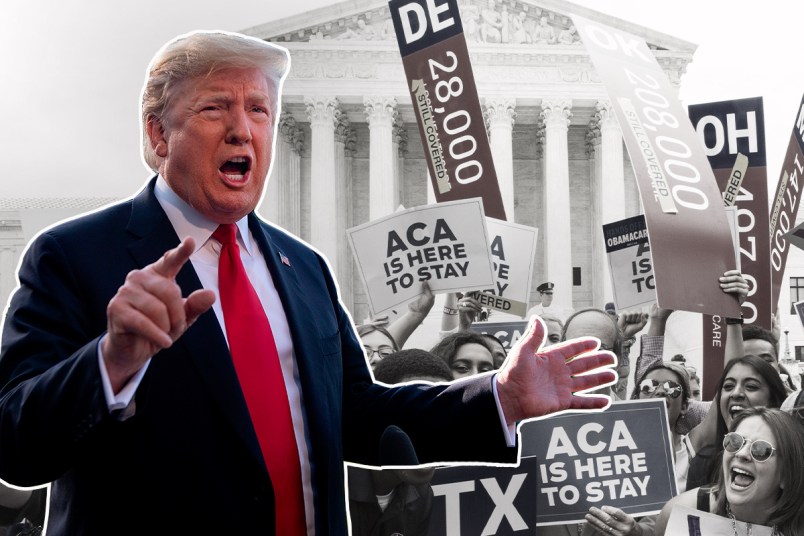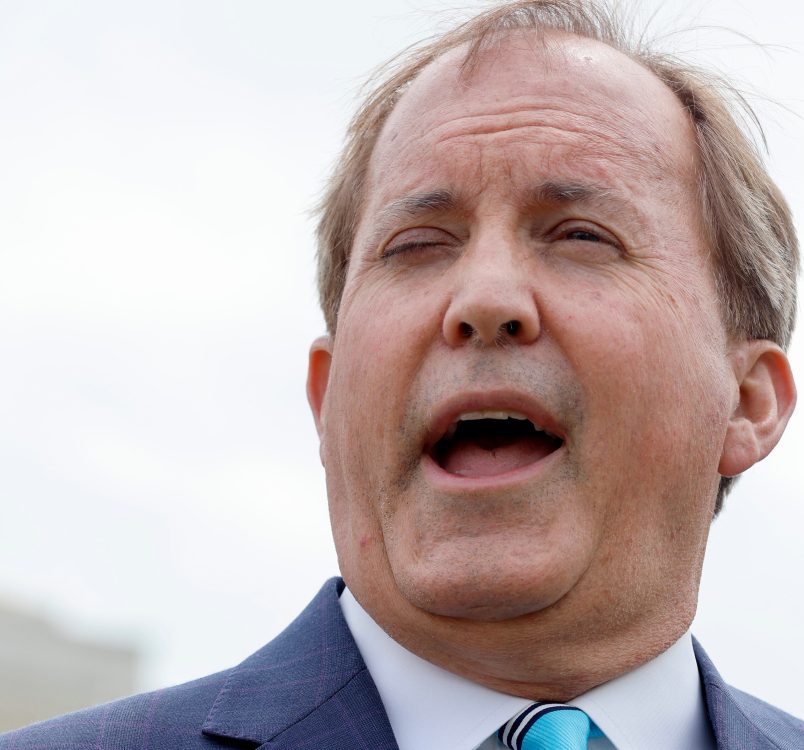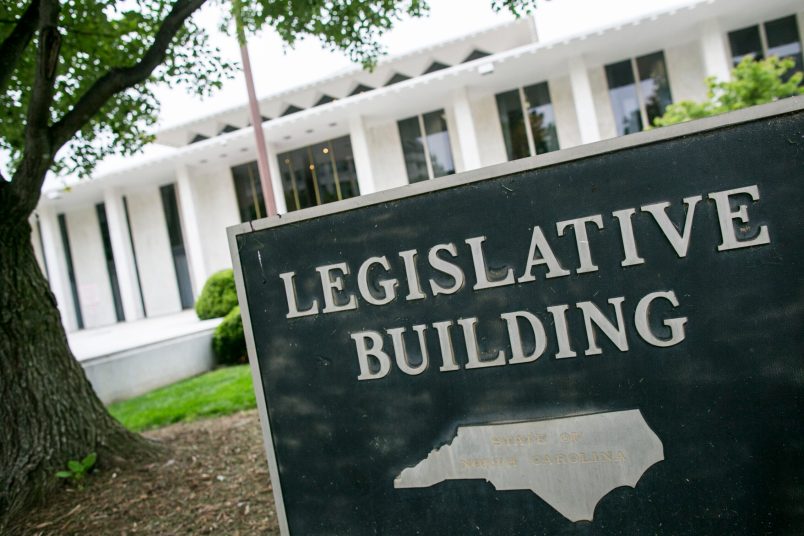For over a decade, Republicans have repeatedly sought to demolish the Affordable Care Act. But the anti-Obamacare case currently in front of the Supreme Court is the first time they’ve tried to do so amid a pandemic.
The political danger of seeking to dismantle the Affordable Care Act as the coronavirus rages has reportedly prompted even top Trump administration officials to rethink their position on the case, in which the government is arguing for a full invalidation of the law.
President Trump, nonetheless, said last week that his administration wants to “terminate” Obamacare, and that it’s sticking with the red states that brought the case.
A Supreme Court decision in their favor would add to the chaos already overwhelming the health care system. The role Obamacare is playing in boosting the U.S.’ coronavirus response is especially significant, health care policy experts told TPM.
It’s not just who the Affordable Care Act covers, but how it covers them. The law has also made possible several of the relief measures recently passed by Congress. Many aspects of how the government is addressing COVID-19 would be scrambled if Obamacare was wiped off the books and the impacts of economic catastrophe felt more deeply without the safety net the health care law provides.
Here are five points on the the current Supreme Court Obamacare case implicates the U.S.’ coronavirus response:
Obamacare’s Safety Net Expands In Times Of Crisis, Like A Pandemic
Without Obamacare, the U.S. would have headed into this pandemic with 20 million fewer Americans insured, and thus 20 million more potential virus-vectors who would have weighed seeking treatment for coronavirus-like symptoms against their ability to pay for it.
But that’s just the beginning of the role the ACA stands to play. As unemployment rises and people lose their job-tied insurance, even more Americans are likely to depend on the law for coverage, meaning several more million would likely be uninsured if it was dismantled during this downturn.
The Urban Institute recently looked at the industries that are particularly hard-hit by COVID-19 — such as retail, restaurants and barber shops — and estimated that 70 percent of workers in those industries, if they lost their jobs, would qualify for Medicaid, or the subsidies on the market exchanges for them and their families.
The “vast majority” of the eligibility comes from Affordable Care, according to Linda Blumberg, one of the study’s authors.
“If the ACA were eliminated there would basically not be an option for those people,” Katherine Hempstead, a health care expert at the Robert Wood Johnson Foundation, told TPM.
Comparing Medicaid expansion and non-expansion states shows the repercussion of undoing that aspect of the law, as the Trump administration is asking the Supreme Court to do.
Prior to the ACA, nearly half of unemployed Americans lacked insurance. Obamacare cut that number down significantly, but in expansion states, the uninsured rate among unemployed Americans is down to 22 percent, while in non-expansion states it’s at 43 percent, according to another Urban Institute study.
During a pandemic, maintaining coverage is not just about individuals’ ability to protect themselves, it’s also about keeping it from spreading to others.
“There’s something at stake here, not just for the individual covered lives, but for the larger communities and society as a whole,” said John McDonough, a professor at Harvard’s School of Public Health.
Coverage Protections For If You Get Covid-19 Will Go Away Without The Law
Among Obamacare’s most popular provisions is its protection for pre-existing conditions and, as AP reported, COVID-19 could be deemed one of those conditions in a world without the Affordable Care Act. Without the ACA’s regulations, insurers could charge people who have suffered from COVD-19 extra, exclude coverage of certain treatments, or even refuse to cover them altogether.
“If we went back to that [unregulated] situation where, you know, because they’re beginning to identify significant health complications that could persist through the course of a lifetime, damage to lungs, etc., as a function of people having been infected with the virus, many, many more people may be unable to obtain insurance coverage in this market,” Blumberg said.
On the flipside, some pre-existing conditions — such as diabetes or heart issues — have been shown to exacerbate coronavirus symptoms. The ability for people to continue to get treatment for those other issues could affect how deadly the virus is once they contract it.
Likewise, Obamacare’s end of annual and lifetime caps are key protections, even with Congress stepping in to instruct insurers to cover certain COVID-19 treatments.
“If you get affected badly by the virus, then you can still face some substantial and costly expenses that could end up, in the pre-ACA world, getting you uncovered because you passed your annual benefit limit,” McDonough said.
Stemming COVID-19’s Spread Gets Harder Without The Law
Several other market reforms implemented by the ACA are shaping the way people are able to have their coronavirus-related issues covered in the time of the pandemic.
Congress may have stepped in to order that COVID-19 tests be covered cost-free by insurers. But there are other types of treatments patients are receiving when they show up with coronavirus symptoms that insurers are covering (though with some significant cost-sharing) thanks to the Affordable Care Act. That is because the Affordable Care Act mandated that ten essential health benefits be included in insurance plans, including those offered by most employers. Without the requirement, coronavirus patients could still be on the hook for costly medical bills, even if the government had mandated that COVID-19 treatment be covered.
“If you have diabetes, and you’re going to the emergency room to be treated for COVID-19, but a component of your treatment — either in the emergency room or when you’re hospitalized — is about treating the underlying diabetes, the underlying diabetes will not be covered,” said John Auerbach, president of the public health advocacy group Trust for America’s Health.
The Essential Health Benefits provision will also come in handy once a vaccine is available, as the commission that designates which immunizations are covered under the law will likely decide that the vaccine should be included.
Congress Is Relying On Obamacare Infrastructure To Boost Its Response
Many of the government actions to beef up the coronavirus response would have been much more difficult to implement without the infrastructure the ACA put in place.
Ordering that COVID-tests be covered cost-free was more seamless for Congress than it would have been without the ACA, according to Abbe Gluck, a Yale Law professor specializing in health policy. Case in point, Congress’ mandate doesn’t apply to the “alternative” plans that the Trump administration has allowed outside of the ACA.
“The Affordable Care Act had a structure in place, and what Congress did was just turn it up,” Gluck said.
Coronavirus-prompted changes the Trump administration made to how it implements public health programs — such as measures that encouraged telehealth — wouldn’t have had as wide-reaching of an impact on the overall health care system without Obamacare, according to Gluck.
This goes for state actions as well. While the Trump administration refuses to reopen Obamacare enrollment, several states that run their own exchanges have opted to do so. This means that people who didn’t have insurance before the pandemic can get it in those places, regardless of whether they qualify for the special circumstances the ACA allows for enrollment outside the typical enrollment period.
Obamacare Funding Streams Are Helping States Adapt Their Response
The expansion of Medicaid isn’t just vital for the individuals who are eligible for it, it provides a crucial funding stream for states and providers to adapt their health care systems to the pandemic.
The additional federal funding states get through the expansion — under which the federal government covers 90-100 percent of the costs — will be especially critical as the number of Medicare recipients increases and revenues into state coffers shrink.
“Without that federal money, there’s no way the states would be able to continue the level of Medicaid coverage that they have now due to expansion,” Cynthia Cox, an expert at the Kaiser Family Foundation, said. “It would strain state budgets as well as hospitals finances.”
A brief filed Wednesday in the Supreme Court case by Democratic state attorneys general also pointed to Obamacare investment in community health provisions and how its Prevention and Public Health Fund “is supporting state and local efforts to track the spread of coronavirus, enhance laboratory capacity, and expand diagnostic testing.”
The fund didn’t live up to the way it was envisioned, in part because it has been used as a backstop to cuts to the CDC and now makes up 12 percent of CDC;s core budget. Some $622 million from the Public Health fund goes to states and localities annually, and according to Auerbach, much of the funding goes to state public health laboratories and epidemiologists.
“The specialized COVID grants are useless,” Auerbach said, referring to the newly-authorized CDC funding going to states, “unless there are skilled personnel who know how to spend them.”






